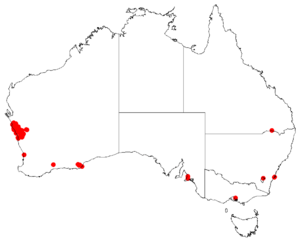Hakea pycnoneura facts for kids
Quick facts for kids Hakea pycnoneura |
|
|---|---|
| Scientific classification | |
| Genus: |
Hakea
|
| Species: |
pycnoneura
|
 |
|
| Occurrence data from Australasian Virtual Herbarium | |
Hakea pycnoneura is a special kind of shrub from the Proteaceae plant family. It has pretty, sweet-smelling flowers that are pink and purple. This plant only grows in a few small areas in Western Australia. It is endemic, meaning it's found nowhere else in the world naturally.
Contents
What Does It Look Like?
This shrub is usually round and a bit open. It has smooth grey bark. It typically grows to be about 2 to 3 meters (6.5 to 10 feet) tall.
Flowers and Leaves
The plant blooms from May to August. It produces clusters of cream-pink flowers. These flowers have a purple base. They grow where the leaves join the stem, or on older parts of the wood. Its flat, thick leaves are about 9 to 20 centimeters (3.5 to 8 inches) long. They sometimes curve and end in a sharp point. Each leaf has a clear vein down the middle.
Fruit
After flowering, the plant grows corky, oval-shaped fruit. These fruit are about 15 to 25 millimeters (0.6 to 1 inch) long. They are also about 8 to 12 millimeters (0.3 to 0.5 inches) wide. The surface of the fruit has small spikes.
How It Got Its Name
The scientific name Hakea pycnoneura was first written down in 1855. This was done by a scientist named Carl Meissner. He described the plant in a book called Journal of Botany and Kew Garden Miscellany. The name comes from two Greek words: pycnos means "close," and neuron means "nerve." This refers to the close veins you can see in the plant's leaves.
Where Does It Grow?
This Hakea species grows in areas with heath and shrubland. It likes sandy, loamy, and gravelly soils. You can find it north of Perth in Western Australia. Its range stretches from Kalbarri to near Morawa. There are also smaller groups of these plants. They grow on the south coast near Mt Ragged and Esperance. In these southern spots, it often grows among quartzite rocks.
Growing Conditions
Hakea pycnoneura is a good plant for gardens. It can handle frost well. It needs a sunny spot to grow best. It also requires soil that drains water easily.
Is It Safe?
The Western Australian Government Department of Parks and Wildlife checks on plants. They have classified Hakea pycnoneura as "not threatened." This means there are enough of these plants in the wild. They are not currently in danger of disappearing.

